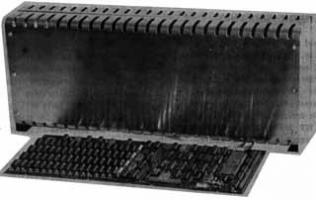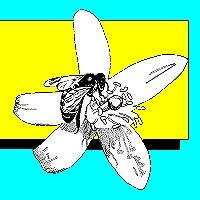APIS Volume 2, Number 7, July, 1984

In this issue
- Jim Herndon Retires--A Florida Benchmark
- The Case for Comb Renovation
- More on High Moisture Honey
- Country of Origin Labeling of Honey
JIM HERDON RETIRES--A FLORIDA BENCHMARK
It is with a certain sense of loss that I received the news of Jim Herndon's planned retirement June 29 as Florida's Chief Apiary Inspector. Jim was one of my first contacts with Florida beekeeping, as he probably was with most beekeepers, and I can think of few better ways to be introduced to beekeeping in any state. Ever since, and in some respects even before, I came to Florida, Jim was a colleague I could rely on. His presence was metaphorically speaking like bedrock, something you could stand solidly on in a world too full of shifting sands.
Jim did a more-than-superb job as chief apiary inspector for the state of Florida. As a registered lobbyist, he helped forge the Florida Apiary Inspection Program into the best in the nation. During his tenure as chief apiarist (1976-1984), the inspection force was increased from nine to twelve full-time inspectors, the Florida honey bee law was considerably strengthened and compensation to beekeepers increased for diseased colonies destroyed by the Inspection Service in the course of its duties. He will be sorely missed as the beekeeper's advocate in Tallahassee.
I was consistently amazed at the prodigous work Jim got from his inspectors. In each of the last two years, for example, over 300,000 colonies were inspected for American foulbrood by just a handful of employees. This vigorous inspection has consistently resulted in a one to one-half of a percent infection rate! Although enforcing some unpopular decisions at times, Jim was first and foremost a beekeeper and always sympathetic concerning the industry's problems. He was also a national leader, active in the Apiary Inspectors of America, and that organization's president in 1982.
I know the beekeeping community wishes Jim well in his retirement. He has assured me that we will continue to be able to see and talk with him at beekeeping conventions. I hope so. A Florida beekeeping meeting without Jim and Annie Herndon just wouldn't be the same.
A CASE FOR NEW COMB
Dr. Elbert Jaycox, who left the University of Illinois and joined the faculty of New Mexico State University in Las Cruces, thinks there might be something to the notion of replacing old comb periodically. His case is presented in a recent issue of The Newsletter on Beekeeping," now being published at New Mexico State University (This was discontinued in the mid 1980s). According to Dr. Jaycox, a tradition in Europe is to routinely replace comb which is so dark light won't pass through with foundation for new comb. This means comb turnover once every three to four years.
The idea raises a few eyebrows in United States' beekeeping circles. Conventional wisdom has dictated that even very old comb is still serviceable. In fact, over a period of years comb gets so strong it can be handled roughly with little chance of destroying its integrity, and so it might be argued the value increases with age. In addition, foundation is expensive and there's no little labor involved in cleaning frames and wiring in foundation. It also costs the bees energy; to make a pound of wax requires seven or so pounds of honey consumption by a colony.
According to Dr. Jaycox, however, there are advantages to replacing old comb. As it becomes older, the cast skins of generations of bees become incorporated into the cell walls. This causes the size of the cells to shrink. Over time, this may result in adult bees as much as seventeen percent smaller than normal. A study by Kerr and Hebling in 1964, indicates that heavier or larger bees begin housekeeping and foraging tasks earlier than lighter or smaller bees. In some cases, the difference was twelve days, enough, Dr. Jaycox says, to make a colony miss out on many a nectar flow.
There are other disadvantages to old, dark comb as well. It definitely discolors honey, but perhaps of most significance, old comb can be a resevoir of disease. Dr. Jaycox quotes Iowa state apiarist Glen Stanley's experiences. The Stanley outfit attributes better wintering and a great reduction in nosema incidence to routine comb culling. New evidence from studies by Nelson and Gochnauer in Canada also suggests that chalkbrood infection is less in new comb. Old combs appear to stimulate fungal growth. Although Dr. Jaycox doesn't mention it, a case might also be made for using foundation and newly drawn comb to discourage wax moth larvae. They don't do very well on foundation or new white comb, but wax fat and juicy (just right for fish bait) on dark comb, which over the years has accumulated a mix of nutrients beneficial to their growth.
Dr. Jaycox encourages beekeepers to think about getting rid of old comb. Not all at once, but over time. He also suggests beekeepers find out for themselves the value of routinely replacing combs by doing some independent experimentation between colonies with black comb and those with newly drawn foundation. As he says, "Stronger colonies, better wintering, less disease, and lighter-colored honey are goals worth striving for."
MORE ON HIGH MOISTURE HONEY
Dr. Jack White, President of Honeytech, Inc., Navasota, Texas was kind enough to send some of his thoughts on reducing moisture in honey to be put under CCC loan. He agrees with my comments in the May issue of this newsletter that reducing moisture before extraction is best, but adds the efficiency of the procedure can be greatly increased by using a dehumidifier and recirculation. He concludes, "Relative humidity of about 30% is easily attained. Killion described the drying of 130 supers of honey from 21 to 17% moisture in 23 days at 80 degrees F in American Bee Journal 90:(1) 14 (1950)."
COUNTRY OF ORIGIN LABELLING
It is now official. As of July 2, 1984, country-of-origin labelling will be required on all retail honey packages. U.S. Customs has just ruled that domestically repackaged honey must be marked to indicate country of origin.
Section 304 of the Tariff Act of 1930, as amended (19 U.S.C. 1304), requires that, unless excepted, every article of foreign origin or its container must be legibly, permanently, and conspicuously marked to indicate country of origin to an ultimate purchaser. This means drums of imported honey must be marked with the country of origin of the honey. Prior to 1983, honey and other natural products (J-list) could be repackaged and sold to ultimate consumers with no information on country of origin. Customs Regulation, 19 CFR 134.25, however, closes this loophole and repackaging no longer can thwart intent of section 304 of the Tariff Act of 1930.
If foreign J-list articles are transformed into new products prior to repackaging, then these different articles of commerce would be exempt from country-of-origin labelling. The Customs Service, however, has ruled that neither filtering, heating, purifying nor blending with domestic honey "substantially transforms" the imported product into a product of the United States. As such, all retail packs with any amount of imported honey must now contain information on country of origin.
Sincerely,
Malcolm T. Sanford
Bldg 970, Box 110620
University of Florida
Gainesville, FL 32611-0620
Phone (352) 392-1801, Ext. 143 FAX: (352)-392-0190
http://www.ifas.ufl.edu/~entweb/apis/apis.htm
INTERNET Address: MTS@GNV.IFAS.UFL.EDU
©1984 M.T. Sanford "All Rights Reserved




















